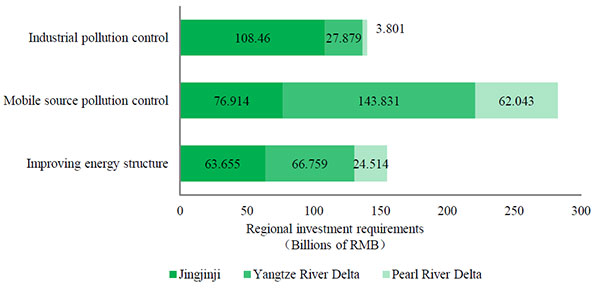
13 Dec, 2015
China needs $293 billion to met 2017 air pollution reduction target
Beijing (China Daily.com.cn) November 20, 2015 – An estimated investment of at least 1.87 trillion yuan ($ 293 billion) is needed to meet the target of the national plan to control air pollution, and current funds are inadequate, said a report on Thursday.
A report, titled Investment Requirements and Potential Effects of Implementing China’s Air Pollution Prevention and Control Action Plan, was released by Clean Air Alliance of China (CAAC) in Beijing on a hazy Thursday. CAAC is an environmental think tank initiated by ten of China’s top universities and government environmental institutions.

High-rise buildings are partly visible in heavy smog in Guangzhou city, South China’s Guangdong province, Jan 31, 2014. (Photo/Yangzi Evening News)
The report is based on two years’ of field research led by the Chinese Academy for Environmental Planning and Nanjing University on airborne pollution and its prevention and control in northern China’s Beijing-Tianjin-Hebei (Jingjinji) region, eastern China’s Yangtze River Delta region and southern China’s Pearl River Delta region and other places.
It shows that at least 1.87 trillion yuan ($ 293 billion) is needed nationwide to meet the 2017 air quality standard set by the national plan, with Jingjinji region costing 249 billion, Yangtze River Delta region 238 billion and Pearl River Delta region 904 billion.In September 2014, China unveiled The Airborne Pollution Prevention and Control Action Plan (2013-17), which was reportedly backed by an investment of 1.7 trillion yuan from the central government.
According to the report, 5 billion yuan and 10 billion yuan of special funds from the central government were invested in airborne pollution prevention and control in 2013 and in 2014 respectively, which falls far short of what is needed.
The report recommended four types of airborne pollution prevention and control measures that require investment.

Estimated investment requirements in airborne pollution prevention and control in Jingjinji region, Yangtze River Delta region and Pearl River Delta region. (Photo from report)
They are energy structure optimization (such as closing down coal-fired boilers), prevention and control of pollution from mobile sources (such as developing new energy vehicles and oil upgrades), industrial sources (such as desulfurization and denitrification in heavy polluting factories) and non-point mobile sources (such as reducing dust from construction sites), which respectively require 284.4 billion yuan, 140.7 billion yuan, 91.5 billion and 61.6 billion yuan.
The investment put in prevention and control of pollution from mobile sources make up 76 percent of all required investment.
Although it requires a sizeable investment, reducing air pollution can stimulate economic growth. Implementing the Control Action Plan is expected to increase China’s GDP by 2.04 trillion yuan and create 2.9 million jobs over the course of five years.
It is also scheduled to exert a dramatic effect on people’s health when PM 2.5 density goes down. By 2017, there would be a reduction of 110,600 chronic deaths per year in China and life expectancy would be extended by an average of 0.24-1.48 years for males and 0.34-3.48 years for females.
In September, the State Council issued an Integrated Reform Plan for Promoting Ecological Progress, which includes carrying out the Pilot Plan for Preparing Balance Sheets for Natural Resource Assets.
The Pilot Plan will quantify the liability and equity on natural resources exploitation and conservation and provide a basis for optimizing governmental and social investment, China Environment News reported.



Liked this article? Share it!